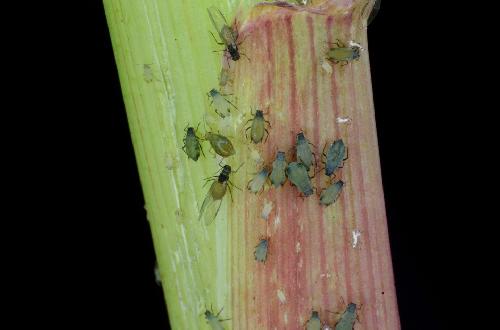Corn seedlings are especially susceptible to hungry insect herbivores, such as caterpillars and aphids, because they lack woody stems and tough leaves. So what's a tender, young corn plant to do?
A recent study by Professor Georg Jander's group at the Boyce Thompson Institute (BTI), finds that corn plants may make serious trade-offs when defending themselves against multiple types of insects. Some corn varieties make themselves more vulnerable to aphids after generating defensive compounds against nibbling caterpillars. The results, which appear in the journal Molecular Ecology, may lead to the development of corn plants that are naturally more resistant to certain insects.
"It's like a metabolic dilemma," said Vered Tzin, a first author and postdoctoral scientist in the Jander laboratory. "When caterpillars are feeding, there's a change in the metabolic pathway that makes chemical defense compounds that protects the plants from caterpillars. But when we studied aphids, it seems like the same compounds that make the plants caterpillar-resistant have the potential to make them aphid-susceptible."
 Herbivorous insects feeding on a corn stalk. Credit: Photo by Meena Haribal.
Herbivorous insects feeding on a corn stalk. Credit: Photo by Meena Haribal.
Corn plants face an onslaught of different herbivorous insects that chew on leaves, pierce and suck out sap or plant cell fluids, bore into stems or consume the roots. Researchers estimate that insects consume 6-19 percent of the world corn crop each year, while also spreading bacteria and viruses between plants.
To defend against these attacks, corn plants have both physical and chemical defense mechanisms. To ward off aphids, plants make callose, a carbohydrate that can seal off openings between cells and to stop aphids from sucking out the sap from the tissues through their needle-like stylet. Callose formation is triggered by a defensive compound called DIMBOA. In the event of a caterpillar attack, plants produce a compound called MBOA that deters their feeding. Both MBOA and DIMBOA are in the same metabolic pathway and come from a molecule called a benzoxazinoid.
Because both defensive compounds come from the same parent molecule, the researchers suspected that feeding by one group of insects, such as chewing caterpillars, might affect the plant's ability to fight off another group, like aphids.
To test this idea, the researchers grew corn seedlings of a common variety, called B73, and exposed some to caterpillars. They then seeded them with aphids and counted the number of offspring that the aphids produced on pristine plants, compared to previously nibbled ones. The aphids consistently produced more offspring on corn that had been pre-chewed by caterpillars.
But, when the researcher tested other corn varieties, individual results would vary. They repeated the experiment with 17 different lines of corn from around the world. Like B73, some varieties supported more aphid offspring after a caterpillar feeding, while the pre-feeding reduced the number of aphids or had no effect on other varieties.
The variation they saw is likely due to the evolutionary history of the different corn varieties. Aphids tend to be more common in temperate areas, such as the Midwest, where they spread barley yellow dwarf virus and cereal yellow dwarf virus, while caterpillars are a larger problem in tropical areas. Different varieties likely arose from breeding programs aimed at fighting off the threats that corn faces in different environments.
To identify genes that may play a role in this interaction, the researchers bred B73 plants with another variety called Ky21, which hosted fewer aphid offspring after caterpillar feeding. Using a genetic approach, they identified three genome regions, on chromosomes 1, 7 and 10, that appear to have a significant impact on a corn plant's aphid susceptibility. By breeding for specific genetic variations that naturally reduce caterpillar and aphid damage, scientists can develop new crop varieties that will require fewer pesticide applications.
In the future, the Jander group plans to use a similar approach to see how corn plants respond to simultaneous attacks from other types of insects and pests that attack different plant tissues.
"We can use a genetic approach to ask ecological questions and try to understand how a plant responds to two organisms," said Tzin, pointing out that most plant-insect research focuses on the plant's response to one type of insect at a time. "We should use more genetic tools to answer ecological questions."
source: Boyce Thompson Institute for Plant Research